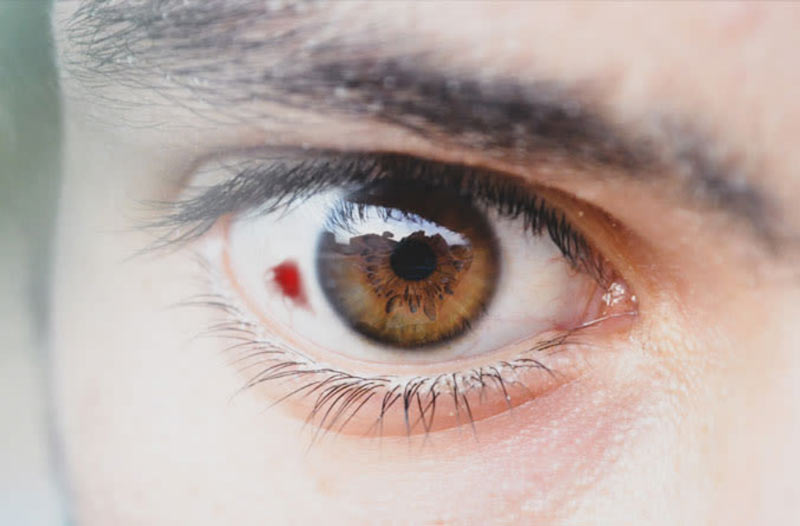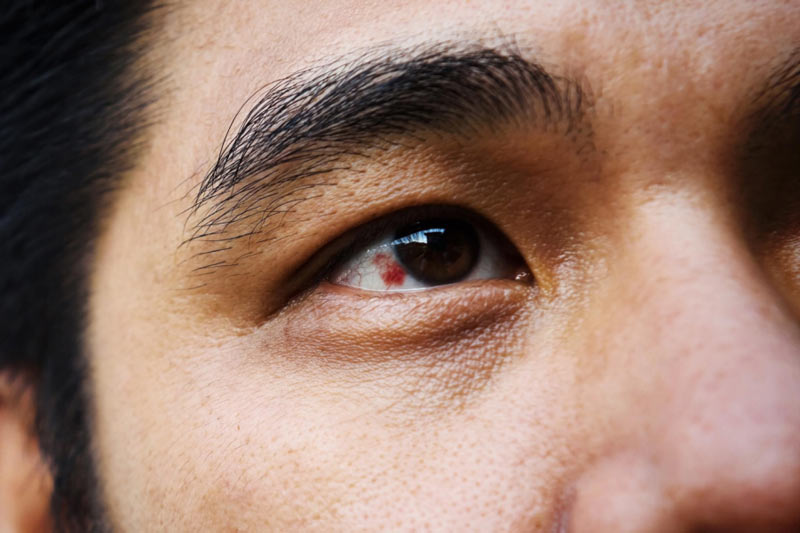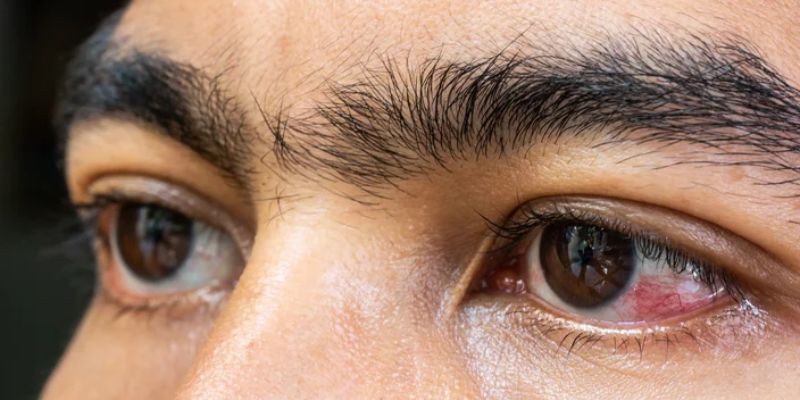Have you ever noticed a bright red spot on your eye? While this may be alarming or cause some concern, it is likely nothing serious. Red spots on the eyes can indicate various conditions, and while some require immediate medical attention, many are temporary and can be treated with at-home remedies.
In this blog post, we will cover the different causes of a red spot on the eye, the symptoms that could accompany it, and what treatments might be necessary depending on your situation.
Red Causes Of Spot On Eye

A red or blood spot on the eye, a subconjunctival hemorrhage, can occur due to various causes. Here is a detailed explanation of the common causes and some rare causes of red spots on the eye:
Sneezing, coughing, vomiting
Forceful actions like sneezing, coughing, or vomiting can temporarily increase pressure in the blood vessels around the eye, leading to a small blood vessel rupture and the appearance of a red spot.
Excess physical strain
Engaging in activities that involve intense physical exertion or straining, such as weightlifting or heavy lifting, can cause blood vessels in the eye to rupture and result in a red spot.
Injury to the eye (trauma)
Trauma to the eye, such as a direct blow or injury, can cause blood vessels to break and lead to a subconjunctival hemorrhage.
Irritation or allergic reactions
Allergies, eye irritants, or exposure to substances that irritate can lead to redness in the eye. Persistent eye rubbing due to irritation can cause blood vessels to rupture and result in a red spot.
Rubbing the eye too hard
Vigorous rubbing of the eyes, especially with excessive force, can cause blood vessels to break and cause a subconjunctival hemorrhage.
Infections
Eye infections, such as conjunctivitis (pink eye), can cause redness and inflammation in the eye. In severe cases, it may lead to a subconjunctival hemorrhage.
Straining to go to the bathroom
Straining during bowel movements or prolonged constipation can increase pressure in the blood vessels, including those around the eye, leading to a red spot.
Contact lens use
Improper or prolonged use of contact lenses, such as wearing them for extended periods or not maintaining proper hygiene, can irritate the eye and result in redness or a subconjunctival hemorrhage.
Conjunctivalchalasis (CCH)
Conjunctivalchalasis refers to the excessive looseness or redundancy of the conjunctiva (the thin membrane covering the white part of the eye). It can irritate and cause redness, potentially leading to subconjunctival hemorrhages.
Rare causes of subconjunctival hemorrhages include:
High blood pressure
Uncontrolled high blood pressure can strain blood vessels and make them more prone to rupturing, resulting in a red spot on the eye.
Blood thinners
Blood-thinning medications, such as aspirin or Coumadin (warfarin), can increase the risk of spontaneous bleeding, including subconjunctival hemorrhages.
Medical disorders that cause bleeding
Certain medical conditions, such as blood clotting disorders or platelet abnormalities, can predispose individuals to spontaneous bleeding, including in the eye.
Diabetes
In individuals with poorly controlled diabetes, the fragile blood vessels in the eye can be damaged, leading to a higher risk of subconjunctival hemorrhages.
Diabetic retinopathy
Diabetic retinopathy is a complication of diabetes that affects the blood vessels in the retina, causing them to become leaky and bleed. This can lead to red spots in the eye.
Symptoms Red Of Spot On Eye

A red spot on the eye can indicate various conditions, and its symptoms may vary depending on the cause. Here are some possible causes and their associated symptoms:
Subconjunctival hemorrhage
This occurs when a small blood vessel in the conjunctiva (the clear membrane covering the white part of the eye) breaks and causes blood to pool under the conjunctiva. Symptoms include:
- Bright red patch or spot on the white part of the eye.
- No pain or change in vision.
- The spot may expand and change color as it heals, usually within two weeks.
Conjunctivitis (pink eye)
This is an inflammation of the conjunctiva, often caused by an infection or allergic reaction. Symptoms may include:
- Redness and swelling of the conjunctiva.
- Itchy, gritty, or burning sensation in the eye.
- Watery or thick discharge from the eye.
- Sensitivity to light.
- Crusting of the eyelids, particularly upon waking.
Corneal abrasion
It is a scratch or injury to the cornea (the eye's clear front surface). Symptoms may include:
- Redness and irritation of the eye.
- The sensation of something in the eye.
- Eye pain or discomfort.
- Blurred or decreased vision.
- Increased tearing.
- Sensitivity to light.
Episcleritis
This is an inflammation of the episclera, the layer between the conjunctiva and the white part of the eye. Symptoms may include:
- Localized redness, often in a specific area.
- Mild to moderate eye pain or discomfort.
- Tenderness when touching the affected area.
- No discharge or significant vision changes.
Pinguecula
It is a non-cancerous growth on the conjunctiva, typically caused by exposure to ultraviolet (UV) light and irritants like dust and wind. Symptoms may include:
- Yellowish or white raised spot on the white part of the eye.
- Redness and inflammation around the spot.
- Mild irritation or dryness.
- Rarely causes pain or vision problems.
Treatment Red Of Spot On the Eye
Warm Compresses
A warm compress on the affected eye can help soothe discomfort and promote healing. Use a clean, lint-free cloth soaked in warm water, wring out the excess water, and gently place it over your closed eyelid for 10-15 minutes. Repeat this several times a day.
Artificial Tears
If the red spot is caused by dry eyes, using over-the-counter artificial tear drops can provide relief. These lubricating eye drops help moisturize the eye and reduce redness. Follow the instructions on the packaging or consult your eye care professional for the appropriate product.
Allergy Medications
If allergies are the underlying cause, your doctor may recommend antihistamine eye drops or oral medications to alleviate the allergic reaction and reduce redness. These medications can help manage the symptoms and provide relief.
Avoiding Eye Irritants
If you have identified any potential irritants, such as makeup, contact lenses, or certain environmental factors, it's advisable to avoid them until the redness subsides.
Prescription Medication
Sometimes, your eye care professional may prescribe topical antibiotics, antiviral medications, or corticosteroid eye drops, depending on the cause of the red spot and any associated symptoms.
FAQs
What are the common causes of red spots on the eye?
Common causes of red spots on the eye include subconjunctival hemorrhage (burst blood vessel), eye allergies, dry eye syndrome, conjunctivitis (pink eye), and eye trauma.
What are the typical symptoms associated with red spots on the eye?
Symptoms may vary depending on the underlying cause, but common symptoms of red spots on the eye include redness, bloodshot appearance, mild irritation or discomfort, a sensation of something in the eye, and sometimes blurry vision.
How can red spots on the eye be treated?
Treatment for red spots on the eye depends on the cause. No treatment is usually required for subconjunctival hemorrhage as it resolves independently. Allergies and dry eye can be managed with over-the-counter eye drops. Conjunctivitis may require prescription eye drops or ointments. In cases of eye trauma, medical attention may be necessary, and treatment options will be determined based on the extent of the injury.
Conclusion
We all need to remember the potential for red spots on our eyes to get them addressed immediately. Different conditions can cause this, so diagnosing the issue accurately before beginning any treatment is essential. Pay close attention to any changes in your eye health and contact your doctor immediately if you notice something new or abnormal. Knowing the causes of red spots on the eyes, the symptoms that may accompany them, and how they can be treated are critical in keeping these issues from becoming long-term problems.




